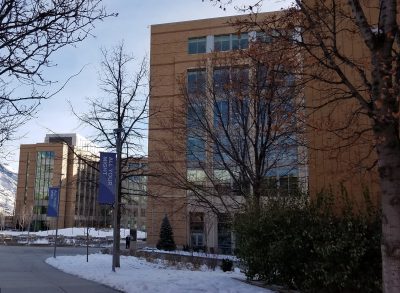
New buildings at the MTC
The Missionary Training Center in Provo, Utah, is located just north of the Brigham Young University campus, very near the site of the dorms we both lived in as freshmen. Although the MTC opened in 1978, a year before we left Provo and moved to Chicago, neither of us had ever set foot inside the forty-acre compound. When young Michael reported for missionary training back in 1974, the Language Training Mission (precursor of the MTC) was housed on the south side of the BYU campus in a collection of old buildings that included a stuffy quonset hut. The new complex offered much more comfortable lodging and classroom space, but it also separated the missionaries-in-training from the regular student community and kept them mostly confined within its security fences. Our three children who served missions came to the Provo MTC for orientation and language training, but we did not bring them as many parents do; we simply took them to the Cincinnati airport and said our goodbyes there. So driving our rental car up to the MTC’s entrance gate just before 10:00 a.m. on Monday 30 December and identifying ourselves to the security guard as new senior missionaries felt like kind of a big deal.
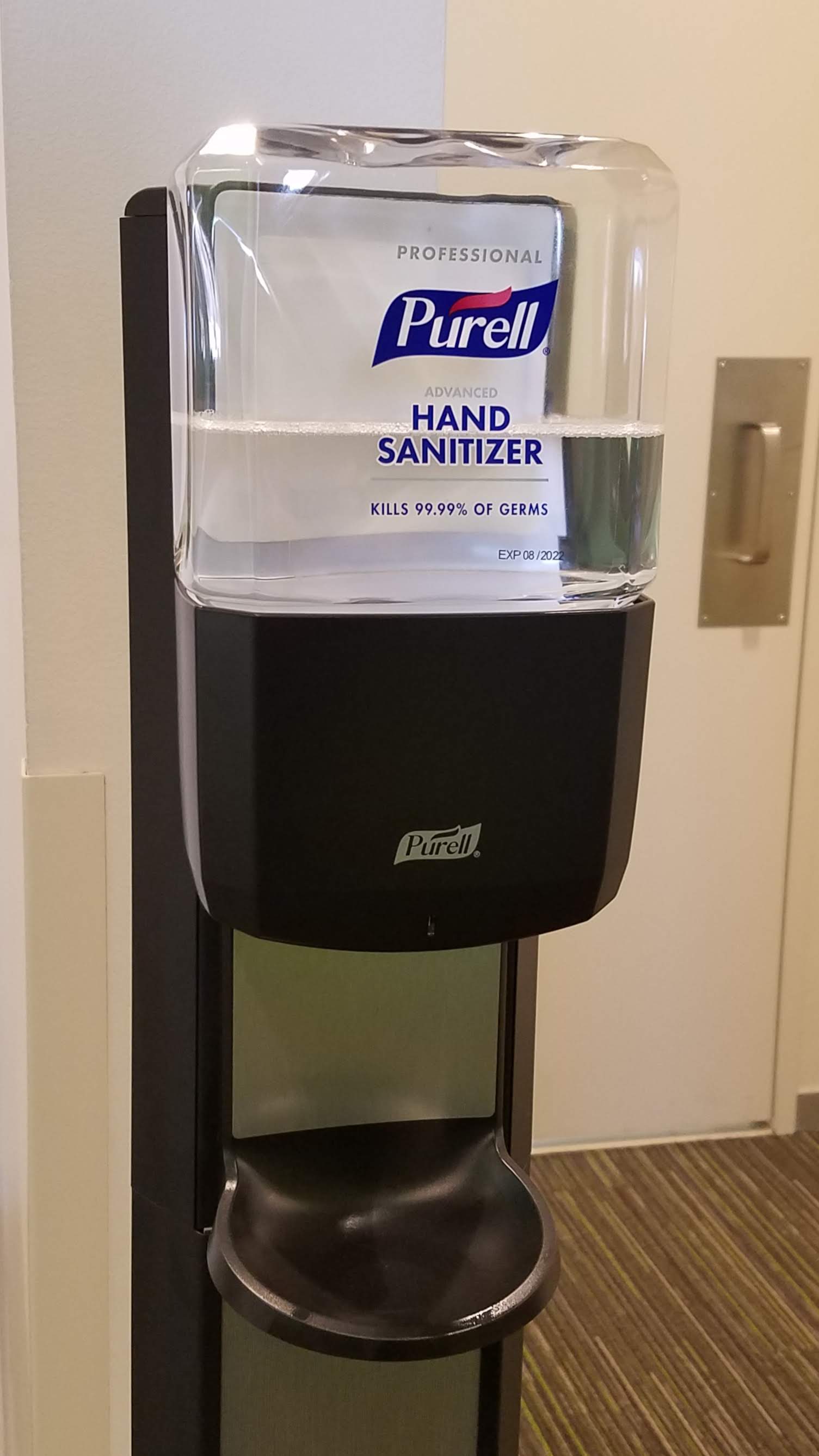
Due to cold and flu season, the MTC instituted a No Touch policy this week: no shaking hands, no hugging, no physical contact at all. Many of these sanitizing stations were set up throughout the compound
We were among the first seniors to arrive, so we took advantage of the chance to get acquainted with a few other couples waiting in the lobby before the registration desk opened. When Michael asked a receptionist how many other senior missionaries would be in our cohort, she replied, “Not too many this week—about eighty”—which sounded to us like a lot. We would soon learn that those eighty missionaries included 36 couples and six single women destined for missions all over the world: many in the U.S. and Canada, others in England, Germany, Poland, Kenya, and the Philippines. Several were going to Hawaii, and there was another couple going to New Zealand, but to a different mission. Our specific assignments were even more varied: several had been called to office positions at Church headquarters in Salt Lake City; some to Member Leader Support services in areas where local Church leadership is still developing; others to facilities construction and maintenance on Church-owned farms and ranches. We were the only ones called as Church History Specialists, so we often had to explain exactly what that meant (even though we still aren’t exactly sure ourselves).
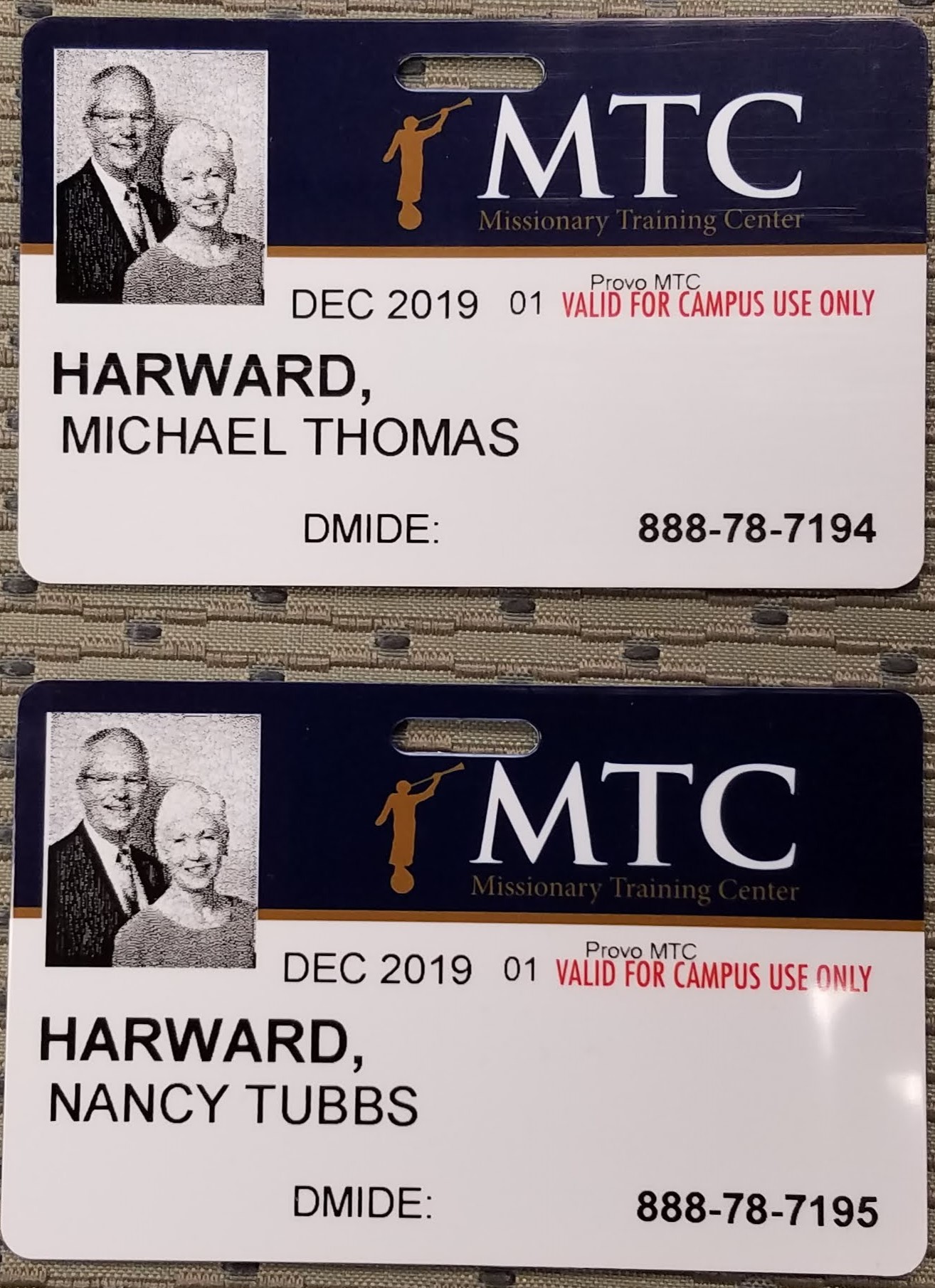
Our ID-key cards
When we checked in, we were given packets containing our travel itineraries and plane tickets, visas for a 23-month stay in New Zealand, the passports we had submitted earlier so the Church Travel Office could obtain our visas, and our official missionary name tags—which we were instructed to wear nearly everywhere except perhaps in the shower and in bed. We also got magnetic key cards to let us into the buildings on the MTC campus. Unlike some of the senior missionaries, we are not staying at the MTC at night; rather, we are staying with Michael’s sister Pat, who lives about half an hour away in Highland. (We gave ourselves extra drive time Monday morning because it had snowed during the night and we weren’t sure what road conditions to expect, but although we were in front of the snowplows on the interstate, the drive wasn’t too bad.)
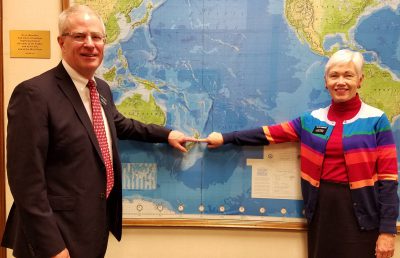
Tradition requires that missionaries get their pictures taken pointing to their assigned destination on the big map outside the cafeteria
Once everyone had checked in, we were divided into three groups for an orientation session led by members of the senior missionaries’ branch and Relief Society presidencies. (In LDS parlance, a branch is a church unit similar to a ward, but smaller; Relief Society is the women’s organization.) We received our schedule for the week and reviewed MTC rules and protocols. Nancy was chagrined to hear the Relief Society president tell the sisters (all women are called “sister”) that it was against regulations to wear open-toed shoes; she must have missed that detail in the dress and grooming guidelines. Should she be obedient and leave the two pairs of sandals she had brought in Salt Lake? (Later, she sent Eva an inquiry and was told: “Bring them. Not a problem here.”)

Evidence that the MTC has not completely eschewed the things of The World
Orientation also included a discussion and diagram of proper navigation through the cafeteria. This, we quickly learned, was vital information, because when lunchtime arrived we were launched into a swirling sea of young missionaries who already knew their way around—this week, 1800 of them. A new cohort of young elders and sisters arrives at the MTC each Wednesday. (Elder is the oxymoronic title for any male missionary, even if he’s still a teenager.) Unlike the seniors, their primary focus is proselyting, so they are here to build gospel knowledge and develop teaching skills. Basic training for young missionaries lasts three weeks; those who also must learn a new language may stay here as long as ten weeks. But because we seniors arrive at the MTC with more church leadership and life experience than the youngsters, we will be here in Provo for only one week.
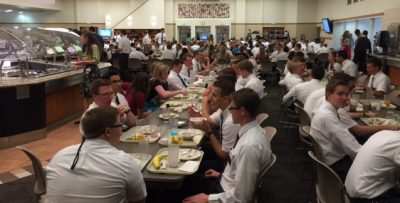
A small section of the MTC cafeteria
Now back to lunch: The cafeteria is enormous. It has only one entrance, at which you present either your meal plan card or your credit/debit card (the latter for us, since we are not staying here 24/7). Then you must jump in and swim your way toward the food line of your choice. There’s the “hot meal” line, which offers a couple of traditional entrees with set sides such as mashed potatoes and cooked vegetables; this is also where the bewildered new missionaries from Asia or Central America can get a bowl of plain rice and/or beans. Then there’s the “fast food” line, where homesick American boys can get as many hamburgers, hot dogs, and corn dogs as they want. And fries—limitless fries. A soup and salad bar offers healthier choices, as does the “fresh” line, where you can order a custom-made wrap or salad with your choice of grilled meats. Other stations offer pizza and pasta, fresh fruit, desserts ranging from cake to cookies to apple streudl, and cold cereal that’s available all day long. We had been told that the food at the MTC was terrible and were relieved to find that it wasn’t as bad as we expected. But yeah, it’s cafeteria food.
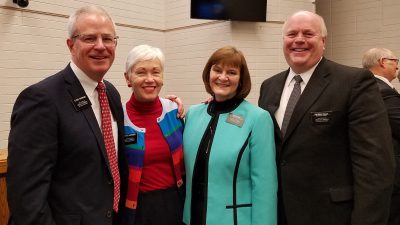
Elder and Sister H with Lori and George R
After lunch, all the senior missionaries gathered in a large hall to meet the MTC presidency and their wives. The wife of one of the president’s two counselors turned out to be a former Blackfoot (Idaho) High School classmate of Michael’s. The other counselor, George R, was our stake president when we moved to Cincinnati. He was the one who called Michael to be a bishop in 2000, so they worked together closely for a couple of years before the stakes in the Cincinnati area were reorganized and George was released as president. He and his wife moved away from Ohio shortly after that and then spent a few years presiding over a mission in the Philippines before their call to serve at the MTC. We love and admire both of them, and it was great to see them again.
Following that meeting, we were divided into “districts”—the small groups with whom we will be meeting for classroom instruction during the rest of the week. Our district comprises three other couples: Elder & Sister D, who are from Utah and have been called to serve as Member Leader Support missionaries in Georgia; Elder & Sister H, who are from Arizona and will serve in the Lubbock Texas Mission office; and Elder & Sister B, who are going to the Deseret Cattle Ranch in central Florida. (Who knew that the Church operates a cattle ranch in Florida?) Elder B is a construction engineer who has been assigned to repair structures damaged by Hurricane Dorian; Sister B will serve as a greeter in the ranch’s visitors center. This is a perfect role for her not only because she has advanced multiple sclerosis and uses a motorized wheelchair rather than construction tools, but also because she has a cheerful attitude and an irresistible smile.
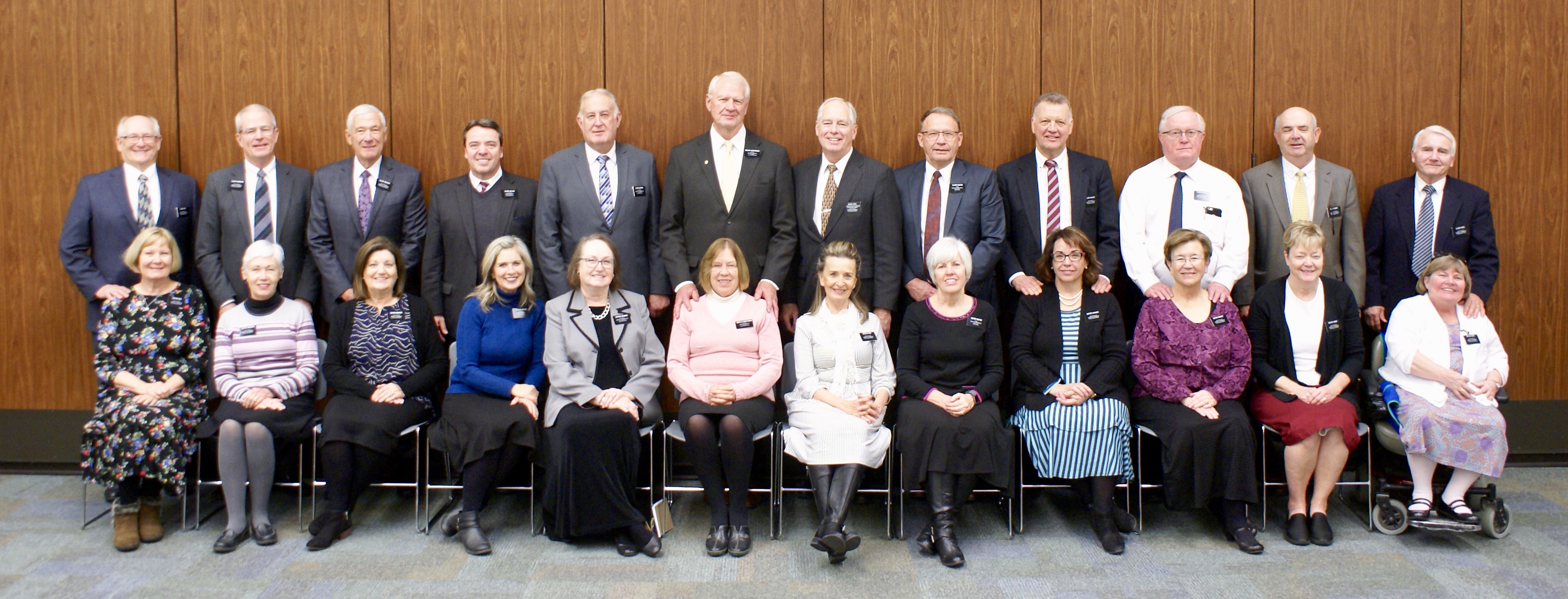
Part of our cohort of senior missionaries. Elder & Sister D are at the far left, next to us; Elder & Sister B are at the far right, next to Elder & Sister H
District classroom sessions are conducted by a contingent of young returned missionaries, most of whom are either current BYU students or recent BYU graduates. Michael had a hard time accepting the idea of being schooled in gospel principles and teaching techniques by a bunch of kids who are several years younger than our own children, but he had to admit that their energy and enthusiasm was infectious. Nancy was impressed with how well they facilitated discussion and encouraged the senior missionaries to share our own experiences and insights.
During the remainder of Monday afternoon, we reviewed the Missionary Purpose Statement found in Preach My Gospel (our official textbook), in which we are commissioned to invite others to come unto Christ by helping them receive the restored gospel through exercising faith in Jesus Christ, repentance (meaning turning toward the Savior and away from sin), baptism, receiving the gift of the Holy Ghost, and then continuing on the path of discipleship throughout their lives. This series of vital principles and ordinances was outlined by Jesus Christ in the Book of Mormon (3 Nephi 11). Known as the Doctrine of Christ, it forms the foundation for all we do as missionaries and as Latter-day Saints.
We also read and discussed the instructions and promises given to Thomas B. Marsh, one of the earliest missionaries called to preach the restored gospel of Jesus Christ after the Church of Jesus Christ of Latter-day Saints was organized in 1830. These are found in Doctrine and Covenants Section 31. The Lord counsels Thomas to be patient, meek, and steadfast, to pray always, and follow the guidance of the Holy Spirit as he goes forth to preach. The Lord then promises Thomas that he will open the hearts of the people to receive him and his message; in addition, God assures him that his family will be blessed if he will serve faithfully. It’s a valuable and comforting message for today’s missionaries as well.
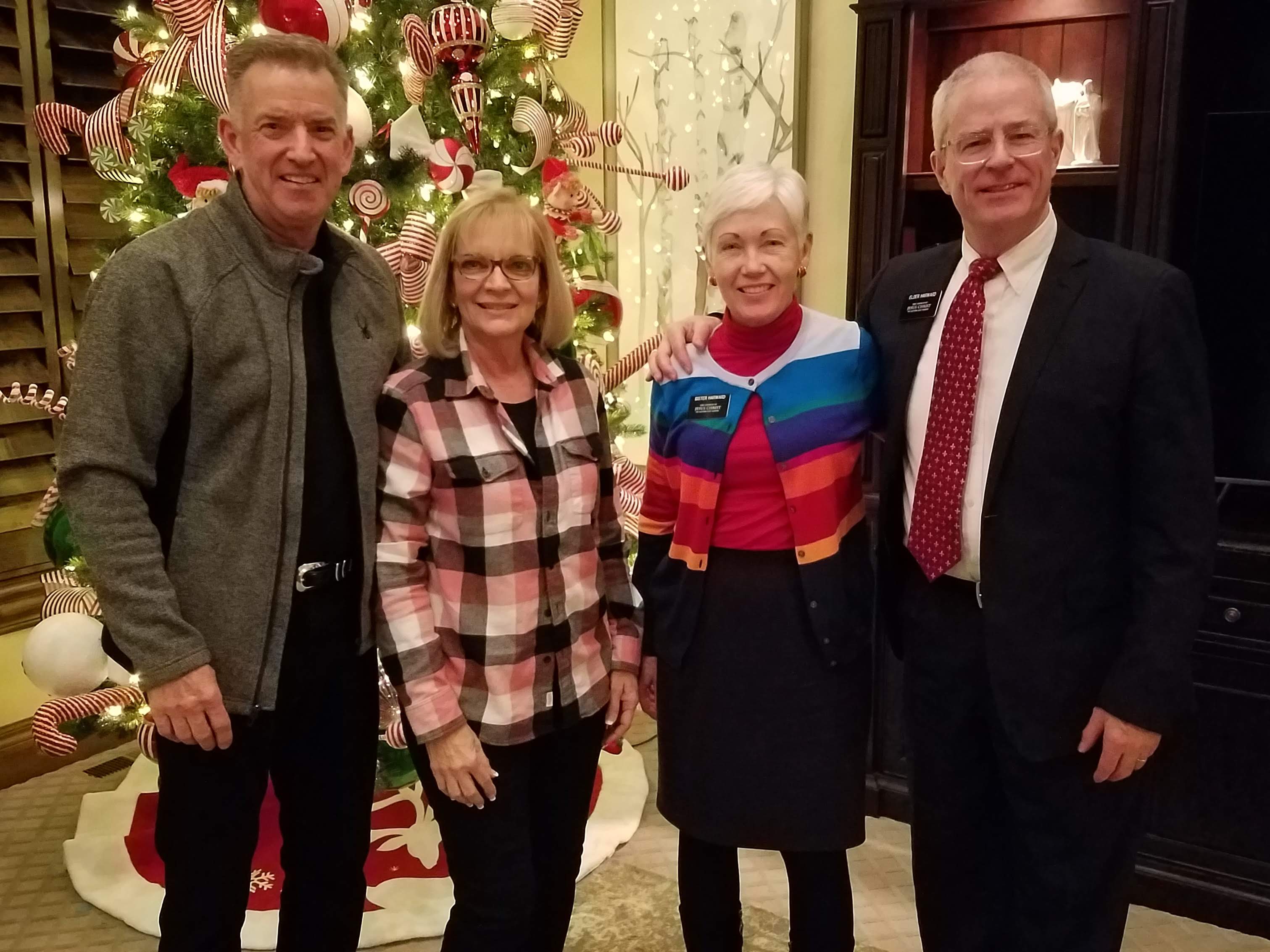
After dinner with Alan and Kathy
By the time we were released from class at 4:30 p.m. Monday, we definitely felt like we had absorbed as much as we could possibly absorb in one day and were thankful that we could look forward to a more relaxing evening. Alan and Kathy, friends who live only a few miles from the MTC, had invited us to join them for dinner. Nancy and Alan had met in kindergarten and maintained a close friendship all the way through high school, graduating in the same class; Kathy had moved into their LDS ward while all of them were in their early college years. When further education and careers took them away from Fullerton, California, Nancy and Alan lost track of each other, reconnecting briefly at a high school choir reunion in 2003, but then losing contact again. A few months ago, Nancy noticed that Kathy had commented on a mutual friend’s Facebook post and used that as a means to reconnect. She was surprised to learn that Alan and Kathy had moved to Provo several years ago, and that Alan had only recently been released as executive secretary to the president of the MTC. So the three former Californians not only had much to reminisce about and catch up on, but all four of us had much to discuss about our MTC experiences and the joys and challenges of parenting adult children. We were reluctant to say goodbye, but realized that we still had a half-hour drive back to Pat’s and needed to get right to bed because the next morning we were due back in class at 8:00 a.m.
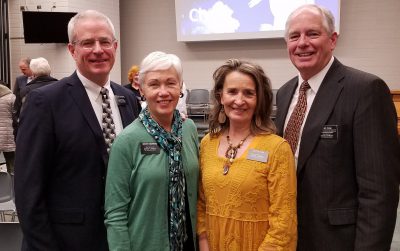
With our “other” couple: Sister and Elder P
On Tuesday we again met as districts to receive more instruction in lesson preparation and teaching techniques. We then had the opportunity to practice those skills on another couple from outside our own district. The “other” couple we were assigned to teach are from Alaska, and they will be serving as facility maintenance missionaries on Church-operated farms in England. Elder and Sister P have been married to each other less than two years. He was divorced and she was widowed, and they met when a mutual friend took Elder P to Sister P’s place after a fishing trip so that she could clean and filet their catch. (Apparently, petite Sister P is a highly skilled outdoorswoman who not only knows how to filet fish but also shoot a moose, skin it, tan its hide, and make boots with the leather.) After they met again at the Anchorage Temple a few months later, it did not take long for both to realize that they would make a good pair—and then to decide that they wanted to serve a mission together. We loved getting acquainted with them and then preparing and presenting a short lesson just for them on the concept of agency. Then we swapped places, and they presented a lesson on Christlike attributes just for us. As we taught each other, our young instructors listened in from behind a screen and then helped us review and evaluate our lessons.
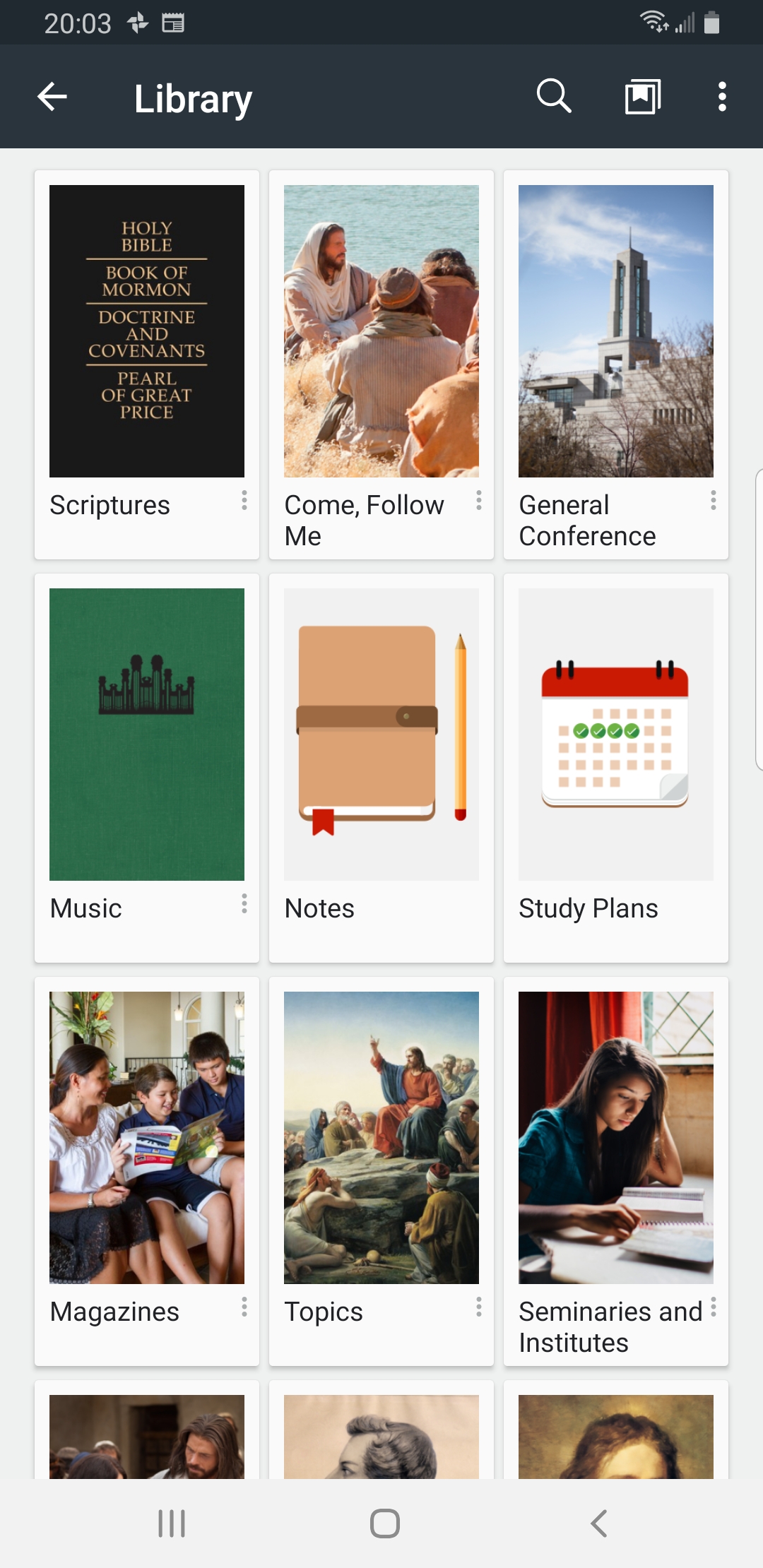
The Gospel Library app
After lunch, all the senior missionaries attended a session on using the Gospel Library app. Dividing into two groups based on whether we use Apple or Android devices, we reviewed (or for some seniors, discovered) the array of digital resources the Church has made available literally at our fingertips. The Gospel Library app is actually quite amazing. It not only provides access to the complete texts of the Bible, the Book of Mormon, other books of scripture, lesson manuals, hymnals, and other Church publications, but it also provides one-touch access to footnotes, cross-references, illustrations, maps, and associated videos and music. You can keep your own notes in a personal digital file, accessible to all your devices, and the whole package is surprisingly user-friendly. We’ve been using Gospel Library almost exclusively for a few years now (indeed, we left our print copies of the scriptures at home in Cincinnati), and Nancy especially appreciated such easy access to a variety of resources while she was teaching Sunday School. So neither Nancy nor Michael needed the group tech-training session, but we recognized that it was helpful for other senior missionaries with less experience using the app.
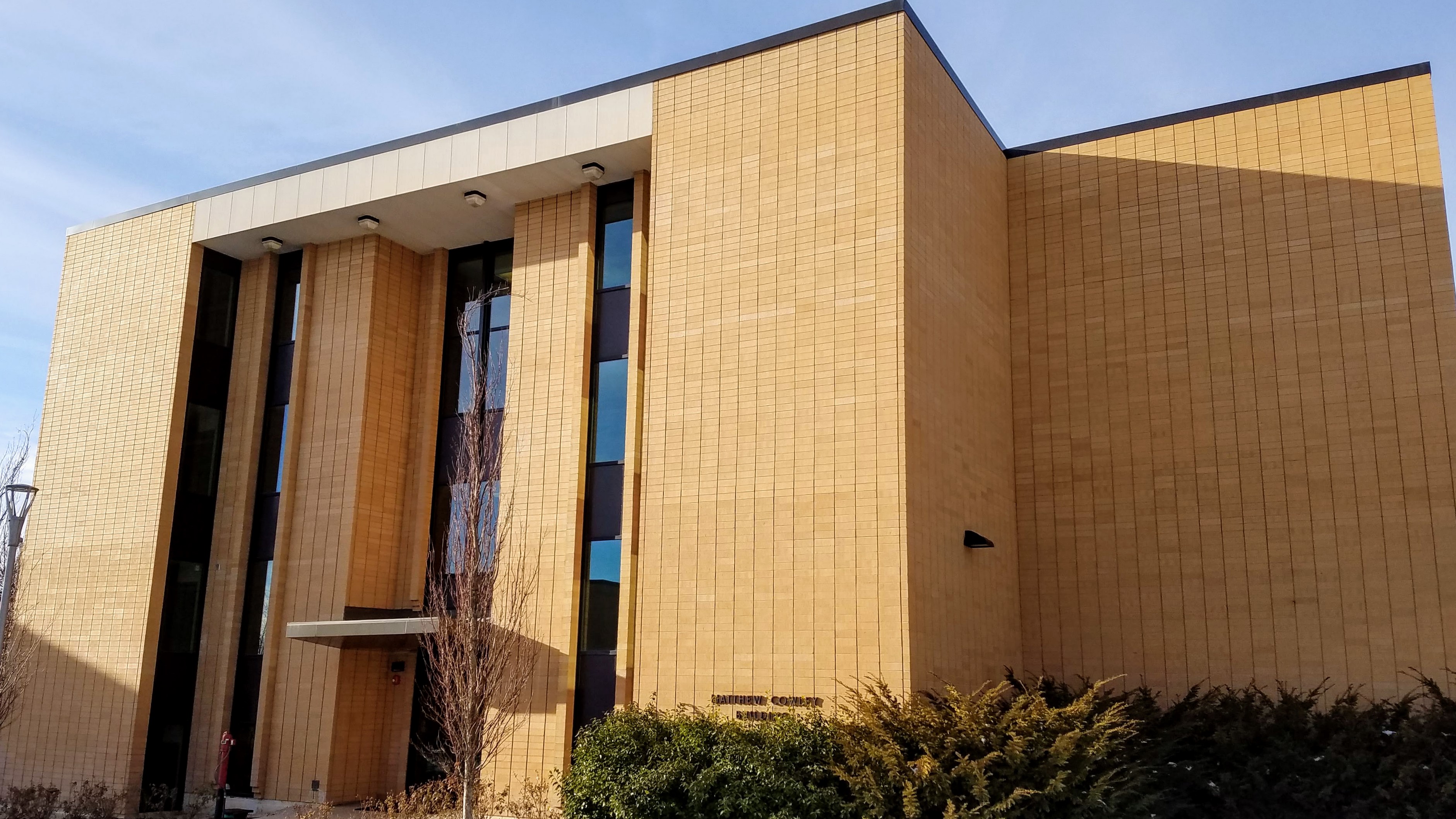
The classroom building where we met as districts was, coincidentally, called the Matthew Cowley Building
The small-group session with our district that followed was more valuable for us. Together, we read a few passages from the Book of Mormon, examining and discussing them phrase by phrase. We appreciated the wisdom and insights shared by each member of our district, and the good spirit that attended our discussion.
Tuesday night we did not leave the MTC until after 9 p.m.—not because we particularly wanted to spend New Year’s Eve with 1800 missionaries, but because Tuesday nights are when general authorities of the Church come and speak at devotional meetings, and we didn’t want to miss the opportunity to hear tonight’s speaker. So we planned to just stay and eat dinner in the cafeteria—which we had to do early (like, 4:30) so we could attend choir practice at 5:15 and then be ready to perform at the devotional, which would begin at 7:00. The devotional speaker would remain a mystery until just before the meeting began. It is not standard practice at the MTC to announce the name of a devotional speaker in advance, so one can never be sure whether to expect to hear the prophet, a favorite apostle, or a lesser-known member of the Quorum of the Seventy (the cadre of men headquartered in Salt Lake City who minister/administer the worldwide Church organization).

Missionaries gather for the weekly MTC devotional
Michael and Nancy were two of the very few senior missionaries who joined with a few hundred young elders and sisters in this week’s MTC choir. It was an interesting experience. During the one-hour rehearsal, we actually sang for only about twenty minutes, the rest of the time listening to the director tell inspiring stories, most of which were only loosely connected to the medley of Primary songs (that is, tunes from the LDS Children’s Songbook) we would perform that evening. The piece was written for four-part harmony but was easily learned, and the point of the practice obviously was not so much to learn the music as to use music to invite the Lord’s spirit into the meeting and into our hearts. It was fun to sing in unity with so many young, energetic voices—and to see how well they responded to the director’s faith-promoting tales. Many people told us later that the choir sounded fabulous, and we believed them.
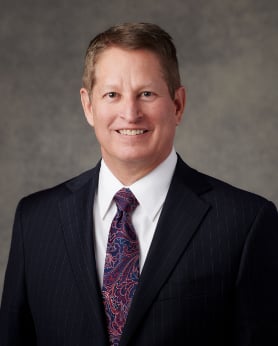
Elder John A. McCune
The devotional speaker was neither the prophet nor a favorite apostle, but a recently called member of the Seventy whom we had never heard before. He was preceded by his wife, who seemed ill at ease speaking to an audience of nearly two thousand but gave an uplifting talk nevertheless. Elder McCune’s talk on turning toward Christ through repentance (again, defined as “changing direction” rather than as something associated with crime and punishment) was very good, and we were glad we had stayed to hear it.
Following the devotional service, everyone was invited to stay seated for a special New Year’s celebration. Being held at the MTC, of course it was unique among the New Year’s celebrations held elsewhere in the world. Ours featured the opening of a time capsule placed in a wall at the MTC on New Year’s Day 2000, at the dawn of the new millennium. The couple who had presided over the MTC at the time were in attendance, along with five former missionaries who also had been at the MTC on 1 January 2000.

End of century celebration glasses
Photos of the contents of the time capsule were projected on the big screen for all to see: a copy of the missionary training guide and lesson manual (“the discussions”) used at the time, with its accompanying cassette tapes; a flip chart with lesson illustrations; and a pair of Harry Potter-style spectacles forming the number 2000—many of which had been distributed to the missionaries-in-training for the historic celebration. (Burger King, McDonalds, and Pizza Hut had donated special treats for the party.) The former president and his wife both spoke briefly about the leading the MTC into the new millennium. They both admitted having initially thought the idea of placing a time capsule was “a little silly,” but looking at the twenty-year-old artifacts made them realize how many things have changed for the better, while others haven’t changed at all. Things of eternal worth—the gospel of Jesus Christ, God’s love for his children—never go out of date.
We don’t know whether the younger missionaries of today were given leave to party like it was 1999 that night; we just went back to Pat’s house and were in bed by 10 p.m.
The rest of our week of instruction at the MTC followed the same basic routine as the first two days: a mix of large-group training sessions, small-group gospel discussions within our districts, and practice teaching sessions with Elder and Sister P, our “other” couple.
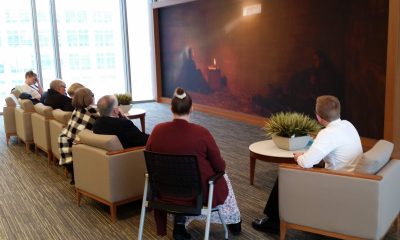
Pondering in front of the mural of Joseph Smith in Liberty Jail
Wednesday morning (1 January) we took a “field trip” to T4, the big new training building on the other side of the compound, where we were introduced to a few of the “pondering areas” that feature huge murals illustrating ancient prophets and others at crucial turning points in their lives: Moses at the burning bush, Esther approaching King Ahasuerus, Paul on the road to Damascus; Nephi gazing toward the gates of Jerusalem, Joseph Smith in Liberty Jail. Some of the twelve murals are photographic, others painted, but all are striking not only because of their size, but also because they are backlit and thus seem to glow from within.
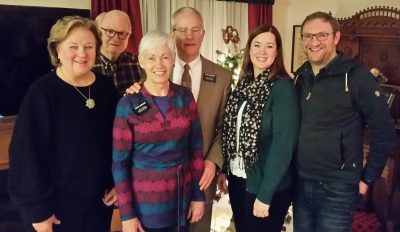
Tracy and Stephen, Nancy and Michael, Emery and Marc after our New Year’s dinner
Wednesday evening we went to Nancy’s sister’s house for dinner. Tracy and her husband Stephen have lived in southwest Provo for nearly twenty years, so they provided a home-away-from-home for all of our children when they came to BYU as students, and many times to us when we have visited Utah Valley. Tonight we were joined by Stephen’s sister Nancy and her husband Dan, visiting from California for the holidays, as well as Tracy’s daughter Emery (whom those of you who have followed our travel blogs may remember from our 2015 trip to Jordan and Israel) and her friend Marc, who was visiting from Amsterdam. Dinner conversation around Tracy and Stephen’s table is always lively, but talk during our New Year’s feast was especially engaging because we all had questions to ask of one another and new stories to share.
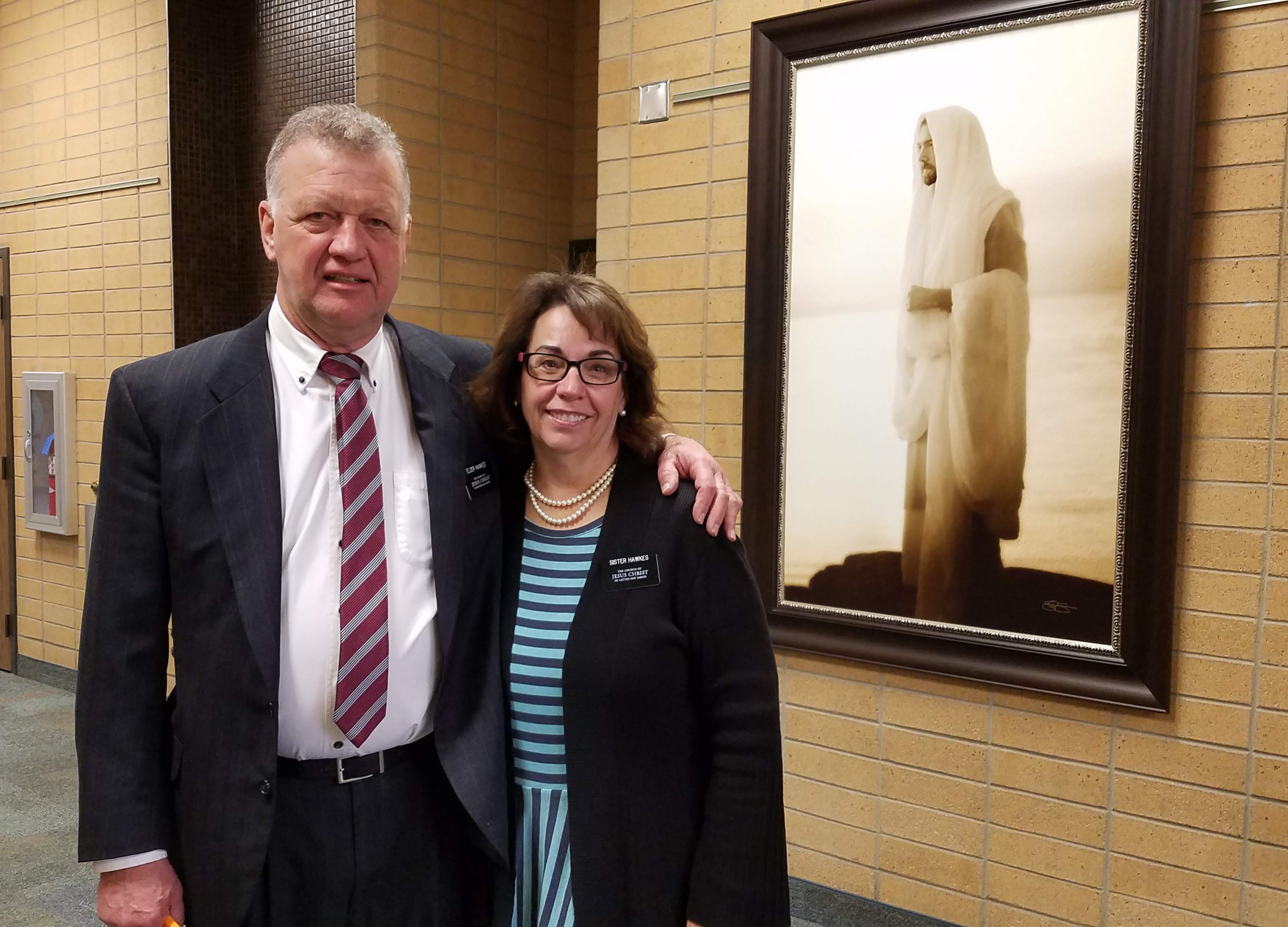
Another Elder & Sister H have done a lot of research on the history of the Church in New Zealand and thus had really hoped they would be called to our assignment, but health challenges require them to stay in the States
On Thursday 2 January, Michael and Nancy skipped a session on missionary safety training, preferring to spend the hour watching a video that had been shown to the other seniors on Monday night while we were dining with Alan and Kathy. The video showed a seminal address given by David A. Bednar (a favorite apostle) at the MTC several years ago called “The Character of Christ.” Other senior missionaries who saw it Monday said it was “fabulous,” so because it’s not available anywhere outside the MTC we asked President R (our friend) if there were some way we could see it this week. He offered to let us watch it on the monitor in his office while he was attending a meeting elsewhere. Elder Bednar’s talk—in which he bluntly tells fledgling missionaries that “it’s not about you, it’s about Christ”— was definitely more inspiring than any safety training could have been.
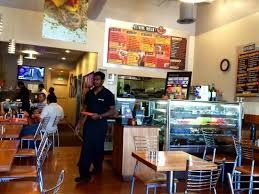
Saffron Valley Canteen in South Jordan
Thursday evening, Myles and Julie, friends who had lived in Cincinnati some years ago but have now moved to Highland, picked us up at Pat’s and took us to dinner at Saffron Valley Canteen, which serves Indian street food. (Myles is even more of a foodie than we are, and has a particular fondness for Indian cuisine. The samosas, puri, and other dishes at this place were excellent.)
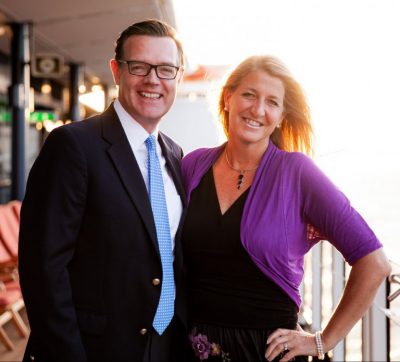
Myles and Julie
Myles had been one of Michael’s counselors in the Montgomery Ward bishopric years ago and recently retired, so he and Julie are preparing to serve a mission as well. Until the end of November, they thought they were headed for Lyon, France, to serve as MLS missionaries, but only a couple of weeks before they were due to enter the MTC, they received a call from one of the apostles informing them that their assignment had been changed. They are now looking forward with excitement and only a little trepidation to presiding over the Benin Cotonou Mission, which encompasses the French-speaking countries of Benin and Togo in West Africa. We think this is a perfect assignment for them, because Myles and Julie are not only fluent in French, but both are relatively young, healthy, energetic, and fantastic people-people. Moreover, Julie already has experience working in a third-world country, having served as a young missionary in Haiti. They will not report for duty until June 2020, but we will be as eager to follow their experiences as we are to begin our own.
A highlight of our time at the MTC was the opportunity we had on Friday 3 January to give a short lesson to a non-missionary volunteer. Young missionaries are often assigned to present lessons to volunteers acting as if they are not already Latter-day Saints, but the pretense is dropped for senior couples because our focus is more on serving and supporting other Church members than on proselyting outsiders. We wish we had had more time to spend with our volunteer, Sister A, because we established an immediate connection and really enjoyed our discussion with her. She told us that before retiring, she had worked on gender equity issues for Utah Valley State University. When we expressed enthusiasm for such a project, she asked why, and then seemed surprised to learn that there are at least a few full-time missionaries who are—like herself—ardent feminists and Democrats. We also encouraged her to consider joining Mormon Women for Ethical Government, about which she had not heard previously (so maybe we did some proselyting after all!). In addition, we presented a short, Spirit-directed lesson on showing love to family members whose lifestyle choices disappoint and worry us, which Sister A seemed to find helpful.
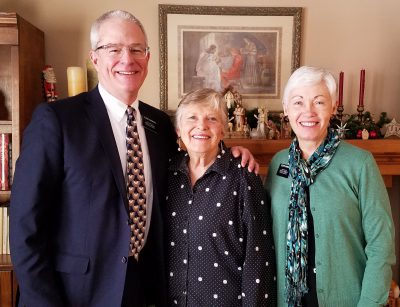
With Janet J
We left the MTC compound for a while at noon on Friday because we had been invited by Janet J, who lives close by, to join her for lunch. Janet’s father had been an early stalwart of the Church of Jesus Christ of Latter-day Saints in Cincinnati, having served a mission there during the post-World War II era, and then returning from Arizona to marry a girl he had met while on his mission. Janet had thus grown up in Cincinnati but had left home many years before we moved into her parents’ ward. Janet’s frequent visits to see her aging parents and other family members who lived in our ward allowed us to get acquainted with her. Our daughter Hillary has fond memories of staying with Janet and her late husband for a few days while she was in high school, when she accompanied Janet’s niece to Provo for a “Y Weekend” event for prospective students, so it was fun for us to see the house where they stayed and enjoy Janet’s hospitality ourselves.
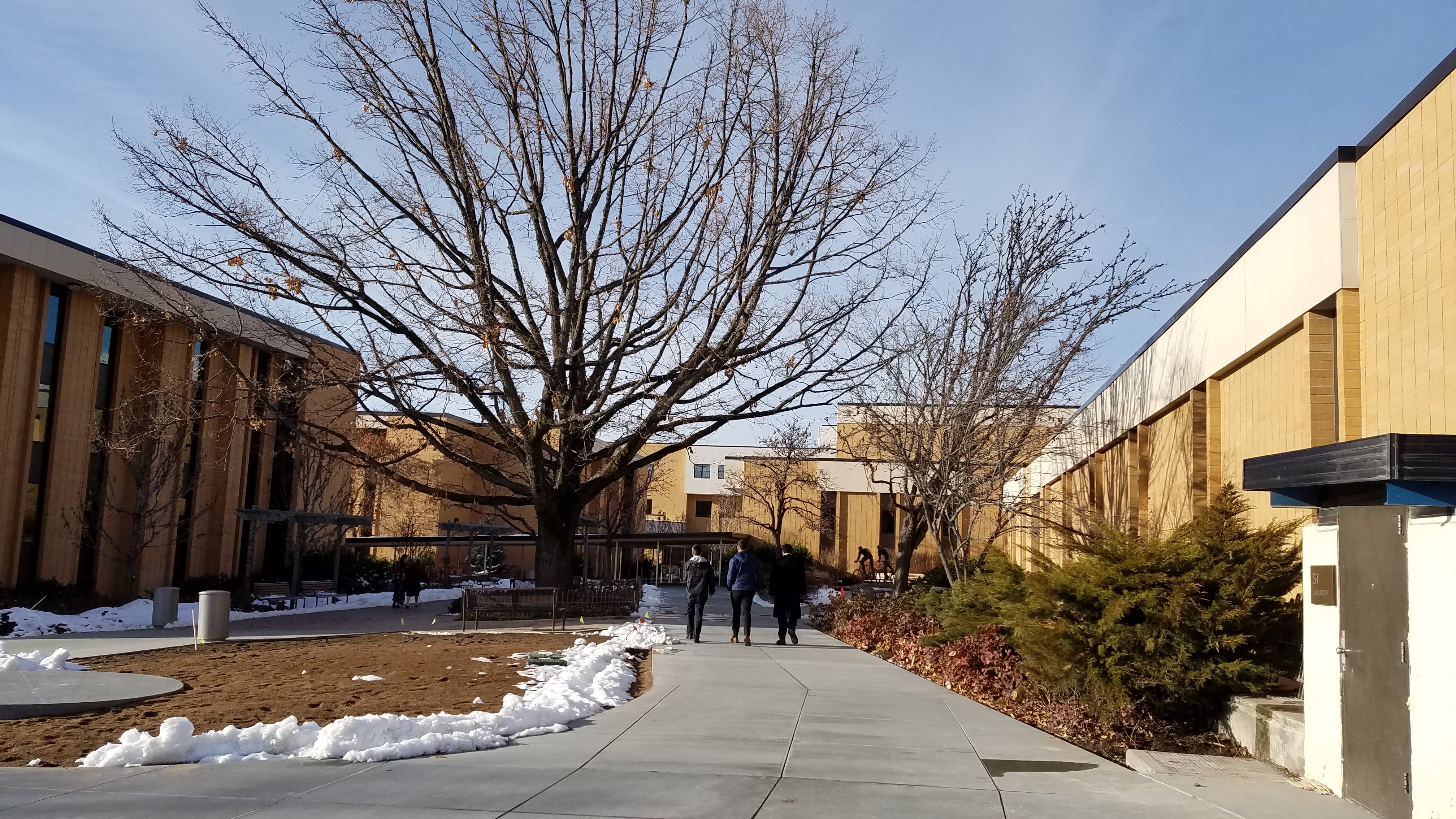
A trio of young elders walking between classes
When the senior missionaries’ workshops ended about 3:30 p.m. Friday afternoon, Michael and Nancy went back to T4 to see the murals in the “pondering areas” we had not had time to look at earlier in the week. (We hear that these will not be reproduced anywhere else, so the only way to see them is to visit the MTC—if you can get in.) We also took advantage of the cold, crisp sunshine to take outdoor photos before we checked out for the last time.
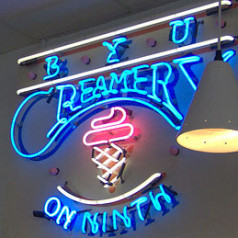
Creamery on Ninth
We had arranged to meet more friends in downtown Provo at 5:00, so since we had about half an hour to kill, we stopped at the Creamery on Ninth. In our student days, the building that is now the Creamery on Ninth had been a small grocery store called Carson’s Market, the dorm dweller’s nearest source of sundries and food items that weren’t served at the Morris Center cafeteria. One can still buy groceries there, but these days most people go for the rich, locally made ice cream.
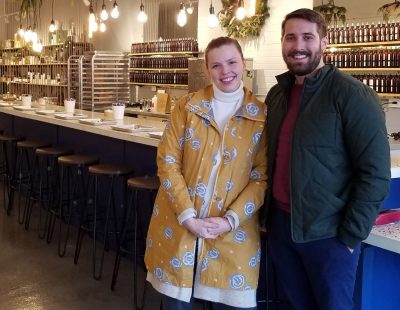
Bari and Bailie, proud proprietors of The Wick Lab
Our destination in downtown Provo was The Wick Lab, a newly opened establishment where customers can create their own candles, scented with a custom mixture of fragrances chosen from among the scores of vials of essential oils lining the walls. The shop is owned and operated by Bari and Bailie, a young couple who met in the Cincinnati Young Single Adult Branch during Michael’s tenure as branch president. Bailie began her first year as a theatre major at the University of Cincinnati College Conservatory of Music just as we were beginning our first year of service in the branch. Bari arrived a year or so later, and served as Michael’s executive secretary after he returned from his mission. Michael claims some credit for bringing the two of them together, having suggested that Bari ask Bailie out. We enjoyed attending many of Bailie’s theatrical performances while she was at CCM, had fun on some double dates with them, and were delighted to attend their wedding in the Salt Lake Temple a few years ago. Bailie has put her acting career on hold for a while because they are expecting their first child soon. It was great to visit with them in their new business, and especially to see them looking so happy.
We didn’t have time to make our own candle, but chose a pre-made peach-scented one to take to Pat, who was cooking dinner for us when we returned to her home that night. She had been out of town during the first few days of our stay at her house, so we were glad that we had that evening to spend together, sharing dinner and playing Cover Your Assets.
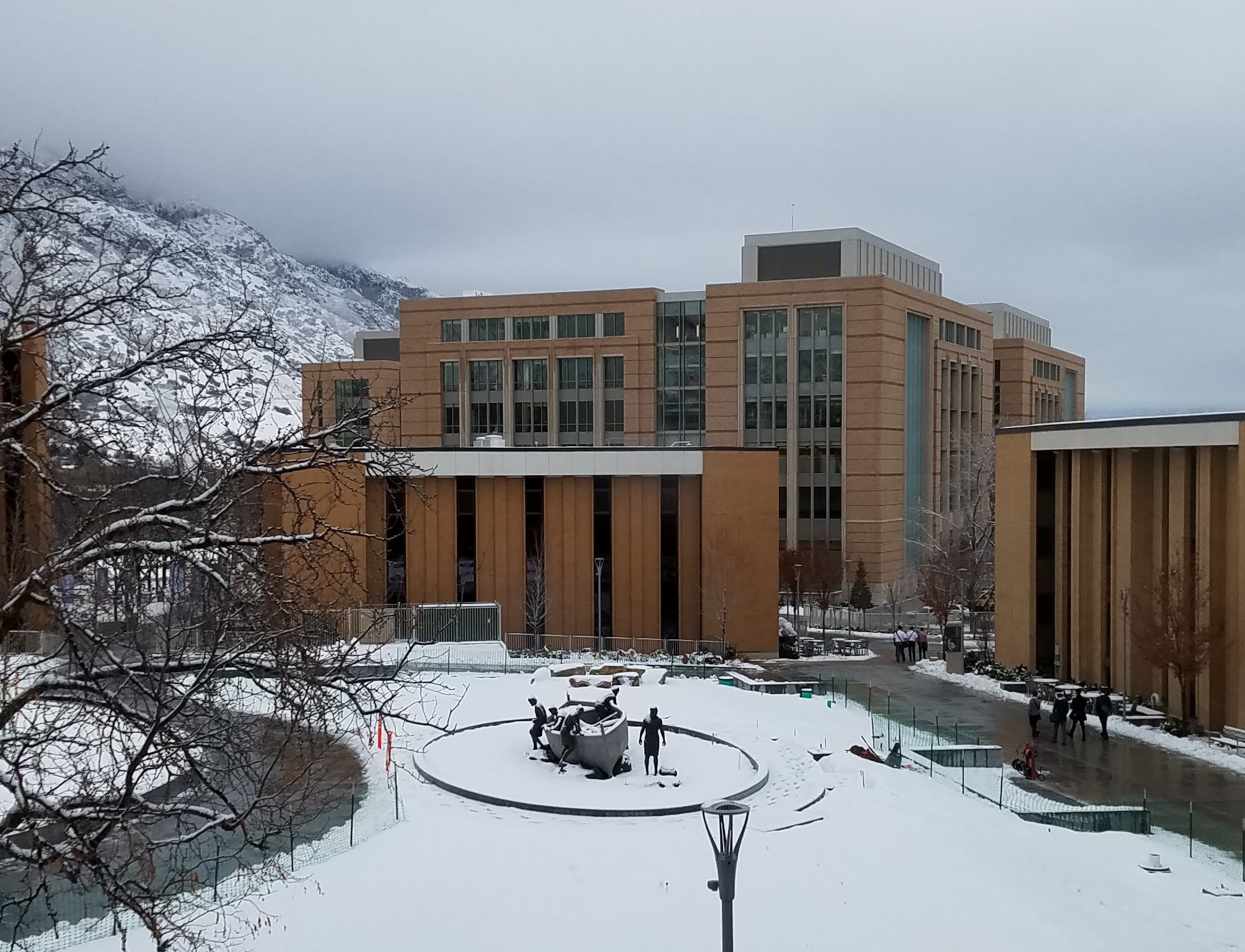
MTC Winter Wonderland, as seen from a window in the Matthew Cowley Building
As we reflected on our week at the Missionary Training Center, we decided that we were glad that we had had the MTC experience, but we also were glad that it was over. There’s a sign at the main entrance to the BYU campus that says: “The world is our campus.” When we were students, we used to joke that the sign should say: “The campus is our world”—but now we realize that the latter statement is really true of the MTC. While we appreciated the enthusiasm of our young instructors and their help in refining our study and teaching techniques, the completely controlled environment had begun to feel stifling. For us, the most valuable part of the experience was our interactions with the other senior missionaries. The mediocre food, the hard chairs, and the hours of regimentation were a small price to pay for the wisdom and insights we gained as we studied the gospel of Jesus Christ with faithful, dedicated people who quickly became dear friends. May the Lord bless us all as we begin our full-time missionary service in many lands and isles of the sea.
Loved reading this. It felt like I was there with you. So glad you got to see some of our old friends, the Ralph’s, Proudfeet, Janet… We wish you the absolute best and are excited to continue to hear about your adventures.
-Randy